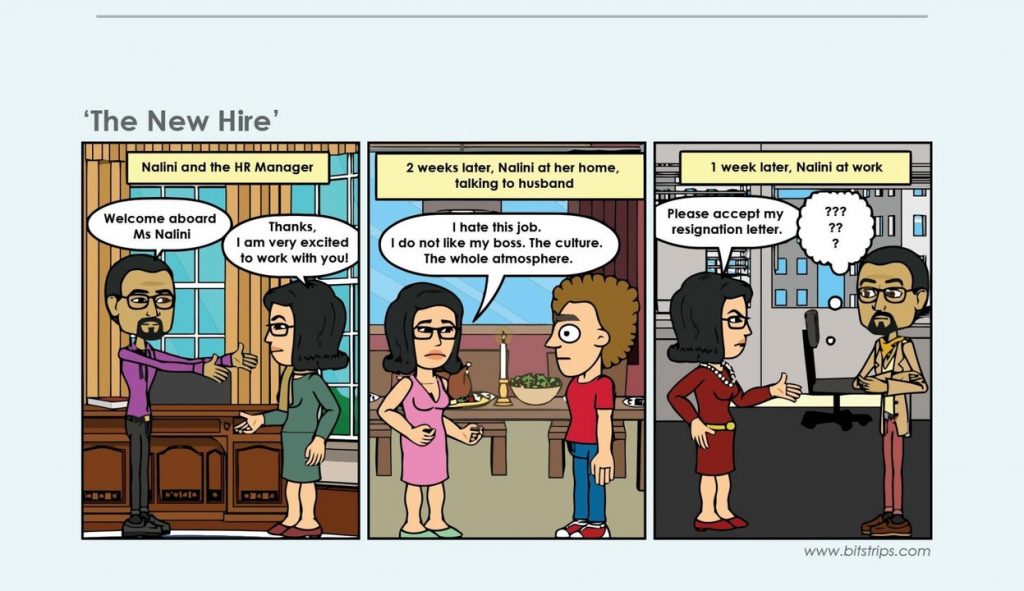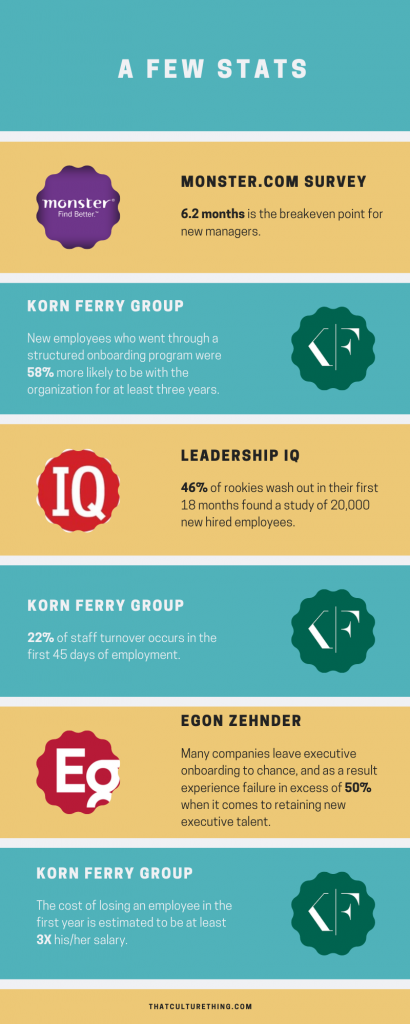
If you are an HR manager, the below illustration must be your “living” recurring nightmare! In fact, a recent research by BambooHR, a software company, stated 31% of people quit their jobs within the first six months. And without a doubt, this is an alarming number.

No matter what business you’re into, what products or services you cater to, it’s essential to know that your most important inventory walks in and out of your office door every day and if you want to remain competent, hiring and retaining the best people is paramount.
And this is where ‘onboarding’ comes in picture. Contrary to the conventional approach, onboarding is not all about getting a few forms filled, orienting new hires about organization’s hierarchy, rules, regulations, reimbursement procedures, leave policy etc. It is more about the strategic orientation of the organization (especially HR) to decrease turnover by increasing engagement.
Onboarding is one the most under focused issues in management, perhaps because the results aren’t immediate and the retention gains aren’t really eye-popping. However, onboarding is a really important aspect in management because if you aren’t adding and retaining good talent, chances are your business may over the time, fall apart.
Despite this, organizations fail to understand the massive significance of the initial 1 to 9-month window to the success of their retention efforts. And regardless of spending so much time, money and effort in recruiting the best candidates, organizations leave these new hires alone to either swim or sink once they are in.
Why did Nalini leave? And why do so many people leave too soon?
Going back to the illustration where Nalini decides to leave the organization 3 weeks after she joins, let’s try to gauge why there are an alarming number of people who leave organizations right within 1 to 8 weeks of joining. It is important to note that every new hire in your organization has formed some perception about your company on the basis of first impressions.
Now the question is whether or not these first impressions make them want to give their 100% to the organization.
While you get ready to onboard new hires, watch out for some of these common pitfalls that cause onboarding programs to fail:-
1. Lack of responsibility: Many times, there is no specific manager or a department that has been given the responsibility to orient the new entrant. As a result, the new entrant is passed back and forth between managers who are oblivious about what to do as they aren’t properly briefed about it. Consequently, the experience of the new entrant becomes really underwhelming.
2. Limited interest or involvement by the management: Many leaders unconsciously believe that onboarding is just a “task” to get done with. On top of that, many HR professionals don’t plan in advance as to how to engage the new hire right on the first day she enters. It is pivotal to schedule a meeting with the management team to deliberate on one question- “What is it that we must do to get the new hire productive faster while also making her excited to come to work?” Doing so will accomplish 2 objectives:-
a) You will get a better buy-in from the management team if they are involved in the beginning
b) It sends out the signal to everybody (even outside! Why? Will share in the last section) that onboarding is taken seriously at your organization
3. Information overboard thus killing new hires’ experience: Like mentioned earlier, for many organizations, onboarding is just an item on the checklist. They just want to be done with it at once, so that the new hire takes the position and starts being productive overnight. As a result, this underwhelms the employees big time, they receive too much information in too little time. It’s suggested that you extend your onboarding program to a longer duration and pass on the information in chunks than overfeeding at once.
Ways to Improve Engagement
Successful onboarding is all about engaging new employees. This is all the more important considering the alarming amount of disengagement in the workplaces. The truth is that most people are not inherently disloyal but they look for work that is both satisfying and engaging. Also, it must be noted that being satisfied and engaged isn’t the same thing. While satisfied employees will keep the organization moving but engaged workforce will help the organization grow and succeed. Here are a few ways you can build and improve engagement:-
1. Begin with New Hire Survey: Conduct in-house or off the shelf new hire surveys within at least 3 to 6 months of employees joining. The survey may include questions like: How would you rate your overall satisfaction with the organization? Do you have all the resources you need to be successful? Are you getting to do the work you think you do best? etc. You can also tweak and ask questions relevant to your organizational needs. Get feedback on key issues around Hiring, Induction & aspects of Organization Culture including team environment, relationship with the manager etc. Capture unique external perspectives of new hires effectively to plan further process improvement initiatives to make the organization a friendlier workplace for new employees.
2. Partner with new hires to create individual development plans: While it goes without saying that managers should assign and set clear goals, target, role, and responsibility; however, it doesn’t stop here. Along with this, it is pivotal that managers sit down with each new hire and engage in conversation like:- “Where do you see yourself growing in this company?”, “What are your personal and professional goals you want to attain while you’re with us?”, “What do you want to achieve in life?, “What drives you to come to work every day?”, “How can I/we support you to attain your professional and personal goals?” etc. Engagement comes only when the employees feel respected and know that they have a stake in the success of the organization. Creating individual development plans not only gives new employees success benchmarks but also by asking such questions builds loyalty.
3. Don’t judge too soon and observe the managers: It’s a proven fact that people don’t leave companies, they leave managers. Most often when an employee complains about work, the problem is not always with the job, but with the manager. There is a direct relationship between the shortage of good quality mentors, leaders, coaches & managers in the organization and the shortage of employee loyalty. Most often than not, it is a cause and effect relationship. While it’s difficult to measure the quality of “Leadership”, a good starting point is to talk to the manager and indirectly hold him/her accountable for his/her employee’s performance.
4. Reinforce transparent communication: Always remember that satisfied employees are just getting their monthly paychecks but engaged employees are sincerely contributing to your mission. In order to be engaged, employees need to know the ‘Big Picture’ of the organization and how their day to day tasks/roles are linked to the vision of the organization beyond making money.
5. Start at the top: Make sure that the leadership team of your organization always “walks the talk”. Employees must see the leadership demonstrating the behaviors they are expected to demonstrate. Research has indicated that in companies where leaders model the desired behavior, employees are 55% more engaged, 53% more focused and are more likely to stay at the organization.
6. Be Authentic: We all know that organizations are made of people and not just concrete. Genuine, authentic relationships among managers, employees and leaders inspire trust, credibility and builds comradery. In fact, a study by Blessings White found that managers who showed their human side were rated 59 points higher on critical skills among employees.
7. Teams that play together, stay together: Lastly, have fun! Having fun together not only breaks up the routine but also encourages creativity and collaboration. These simple acts play a pivotal role in boosting employees’ morale. They feel more respected, loved and an integral part of the organization.
Hey, so how’s the new job going on?
This is one question that the new employee is asked the most outside, by friends/family/ex-colleagues etc. when she joins a firm. And oftentimes, the quality of the onboarding program determines the quality of the answer.
What happens when an ex-employee or a current employee raves about the organization to his/her friends, family, on Facebook, Twitter, and LinkedIn? And alternatively, what happens when he/she talks negatively about the organization? Well, you know the answer to that.
So in a nutshell, to create robust organizations, employee engagement is paramount.
Always remember, your number one customers are your people. Look after your employees so that they look after your customers.
_________________________________________________________________
Please share your feedback, new hire experiences and views in the comment section below.






Share This
Share this post with your friends!